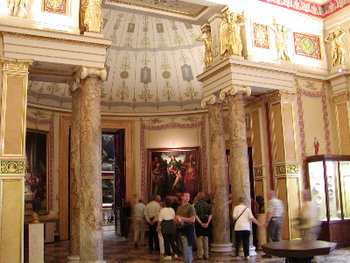Exedra
|
|
In architecture an exedra is a semicircular recess, headed by a half-dome, which is usually set into a building's facade. The original Greek sense (a seat out of doors) was applied to a room that opened onto a stoa, ringed with curved high-backed stone benches, a suitable place for a philosophical conversation. An exedra may also be expressed by a curved break in a colonnade, perhaps with a semi-circular seat.
A classic example of an exedra on a (comparatively) reduced scale within its context, is the central niche of the Trevi Fountain (illus. at that entry) in Rome, sheltering a statue of Neptune. Many classicizing bandshells in public parks are exedras (exedrae is owlishly correct), for the shape, with its half-dome heading, reflects sound forwards. The Hollywood Bowl's shell (illus. at that entry) takes the form of the head of a gargantuan exedra, stripped of classicizing details.
Hypocaustum.jpg
In Muslim architecture, the exedra becomes a mihrab and invariably retains religious associations, wherever it is seen, even on the smallest scale, as a prayer niche.
Both Baroque and Neoclassical architecture used exedras, Baroque architects to enrich the play of light and shade and give rein to expressive volumes, Neoclassical architects to articulate the rhythmic pacing of a wall elevation. The interior exedra was richly exploited by Scottish neoclassical architect Robert Adam and his followers (see James Cameron's exedra illustration above, left).
External link
- LacusCurtius website: (http://penelope.uchicago.edu/Thayer/E/Roman/Texts/secondary/SMIGRA*/Exedra.html) "Exedra," in Smith's Dictionary of Greek and Roman Antiquities, (1875)

